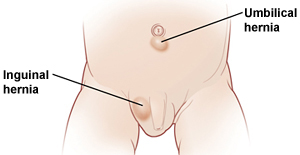Hernias in Children
A wall of muscle holds the bowel (intestine) inside the belly. A hernia is when a small part of bowel pushes out through a weak area of muscle. The hernia looks like a bulge under the skin. Hernias are most common in newborn babies. But they can be found weeks or months after birth.
Why do babies get hernias?
Any baby can have a hernia. But they’re most common in:
Preterm babies (preemies). This is because the wall of muscle in the belly isn’t fully grown yet
Baby boys. This is because it’s easy for a hernia to form in the space where the testicles descend. In baby boys, a bulge in the scrotum is the most common type of hernia. It happens if a passage between the scrotum and belly doesn’t close when the baby is growing in the womb. A part of bowel can move back into the passage. You may not see the bulge all the time. You may see it when your child is straining. This can happen when your child is crying, feeding, or having a bowel movement.
2 types of hernias
Inguinal hernia. This is when a part of the bowel slides into the groin area. This is the crease between the baby’s leg and abdomen. For boys, it may also slide into the scrotum. Surgery is often needed to treat this type of hernia.
Umbilical hernia. This is when a part of the bowel slides into a weak area around the bellybutton. This type of hernia often heals on its own. Surgery is not always needed, but may be if complications occur.
When is a hernia a problem?
In many cases, a hernia isn't dangerous. As long as the part of bowel can move back into the abdomen, it’s OK. But it can be a serious problem if the bowel becomes stuck in the weak spot. This is a serious condition called a strangulated hernia. The belly muscles squeeze the bowel. This causes swelling. Blood flow to that part of the bowel may be reduced. That part of the bowel may burst or the tissue may die. In boys, blood supply to a testicle could be reduced. This can cause damage or death of the testicle.
How is it treated?
The treatment depends on the type of hernia:
Inguinal hernia. This is most often repaired with surgery. Your child will see a surgeon for evaluation and treatment.
Umbilical hernia. This may get smaller over time as your child grows. This can take 1 to 2 years. It could take up to 4 to 5 years. Your child's healthcare provider will continue to check the hernia for problems.
Strangulated hernia. This must be treated right away with surgery. In some cases, the surgeon may want to do surgery before a baby goes home from the hospital, even if the hernia isn’t strangulated to prevent this complication from an inguinal hernia.
What are the long-term effects?
Once a hernia goes away or is treated, most babies have no lasting problems. But, if a hernia is strangulated and blood supply is cut off, this could cause damage to the bowel or testicles. Talk with the healthcare provider about how your baby is likely to get better.
Signs of a strangulated hernia
Watch for the signs below. Any of these may mean that your baby’s hernia is strangulated. Get medical care right away if your baby has any of these:
Crying that can’t be comforted, which can mean your baby is in pain
Crying or fussing when you touch the hernia
Hernia that doesn’t move back into the abdomen
Redness or blue color in the groin, scrotum, or bellybutton
Swollen, round belly, which can be a sign that food isn’t passing through the bowel
Vomiting
